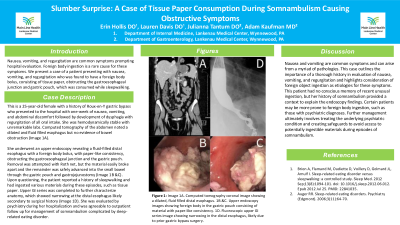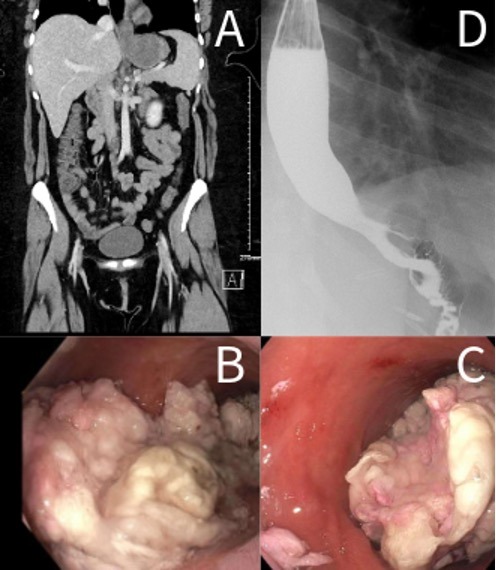Tuesday Poster Session
Category: Esophagus
P4009 - Slumber Surprise: A Case of Tissue Paper Consumption During Somnambulism Causing Obstructive Symptoms
Tuesday, October 29, 2024
10:30 AM - 4:00 PM ET
Location: Exhibit Hall E

Has Audio
- EH
Erin Hollis, DO
Lankenau Medical Center
Wynnewood, PA
Presenting Author(s)
Erin Hollis, DO, Lauren Davis, DO, Julianna Tantum, DO, Adam Kaufman, MD
Lankenau Medical Center, Wynnewood, PA
Introduction: Nausea, vomiting, and regurgitation are common symptoms prompting hospital evaluation. Foreign body ingestion is a rare cause for these symptoms. We present a case of a patient presenting with nausea, vomiting, and regurgitation who was found to have a foreign body bolus, consisting of tissue paper, obstructing the gastroesophageal junction and gastric pouch, which was consumed while sleepwalking.
Case Description/Methods: This is a 25-year-old female with a history of Roux-en-Y gastric bypass who presented to the hospital with one week of nausea, vomiting, and abdominal discomfort followed by development of dysphagia with regurgitation of all oral intake. She was hemodynamically stable with unremarkable labs. Computed tomography of the abdomen noted a dilated and fluid filled esophagus but no evidence of bowel obstruction (Image 1A).
She underwent an upper endoscopy revealing a fluid-filled distal esophagus with a foreign body bolus, with paper-like consistency, obstructing the gastroesophageal junction and the gastric pouch. Removal was attempted with Roth net, but the material easily broke apart and the remainder was safely advanced into the small bowel through the gastric pouch and gastrojejunostomy (Image 1B &C). Upon questioning, the patient reported a history of sleepwalking and had ingested various materials during these episodes, such as tissue paper. Upper GI series was completed to further characterize anatomy, which showed narrowing at the distal esophagus likely secondary to surgical history (Image 1D). She was evaluated by psychiatry during her hospitalization and was agreeable to outpatient follow up for management of somnambulism complicated by sleep-related eating disorder.
Discussion: Nausea and vomiting are common symptoms and can arise from a myriad of pathologies. This case outlines the importance of a thorough history in evaluation of nausea, vomiting, and regurgitation and highlights consideration of foreign object ingestion as etiologies for these symptoms. This patient had no conscious memory of recent unusual ingestion, but her history of somnambulism provided a context to explain the endoscopy findings. Certain patients may be more prone to foreign body ingestion, such as those with psychiatric diagnoses. Further management ultimately involves treating the underlying psychiatric condition and creating safeguards to avoid access to potentially ingestible materials during episodes of somnambulism.

Disclosures:
Erin Hollis, DO, Lauren Davis, DO, Julianna Tantum, DO, Adam Kaufman, MD. P4009 - Slumber Surprise: A Case of Tissue Paper Consumption During Somnambulism Causing Obstructive Symptoms, ACG 2024 Annual Scientific Meeting Abstracts. Philadelphia, PA: American College of Gastroenterology.
Lankenau Medical Center, Wynnewood, PA
Introduction: Nausea, vomiting, and regurgitation are common symptoms prompting hospital evaluation. Foreign body ingestion is a rare cause for these symptoms. We present a case of a patient presenting with nausea, vomiting, and regurgitation who was found to have a foreign body bolus, consisting of tissue paper, obstructing the gastroesophageal junction and gastric pouch, which was consumed while sleepwalking.
Case Description/Methods: This is a 25-year-old female with a history of Roux-en-Y gastric bypass who presented to the hospital with one week of nausea, vomiting, and abdominal discomfort followed by development of dysphagia with regurgitation of all oral intake. She was hemodynamically stable with unremarkable labs. Computed tomography of the abdomen noted a dilated and fluid filled esophagus but no evidence of bowel obstruction (Image 1A).
She underwent an upper endoscopy revealing a fluid-filled distal esophagus with a foreign body bolus, with paper-like consistency, obstructing the gastroesophageal junction and the gastric pouch. Removal was attempted with Roth net, but the material easily broke apart and the remainder was safely advanced into the small bowel through the gastric pouch and gastrojejunostomy (Image 1B &C). Upon questioning, the patient reported a history of sleepwalking and had ingested various materials during these episodes, such as tissue paper. Upper GI series was completed to further characterize anatomy, which showed narrowing at the distal esophagus likely secondary to surgical history (Image 1D). She was evaluated by psychiatry during her hospitalization and was agreeable to outpatient follow up for management of somnambulism complicated by sleep-related eating disorder.
Discussion: Nausea and vomiting are common symptoms and can arise from a myriad of pathologies. This case outlines the importance of a thorough history in evaluation of nausea, vomiting, and regurgitation and highlights consideration of foreign object ingestion as etiologies for these symptoms. This patient had no conscious memory of recent unusual ingestion, but her history of somnambulism provided a context to explain the endoscopy findings. Certain patients may be more prone to foreign body ingestion, such as those with psychiatric diagnoses. Further management ultimately involves treating the underlying psychiatric condition and creating safeguards to avoid access to potentially ingestible materials during episodes of somnambulism.

Figure: Image 1A. Computed tomography coronal image showing a dilated, fluid filled distal esophagus. 1B & C. Upper endoscopy images showing foreign body in the gastric pouch consisting of material with paper-like consistency. 1D. Fluoroscopic upper GI series image showing narrowing in the distal esophagus, likely due to prior gastric bypass surgery.
Disclosures:
Erin Hollis indicated no relevant financial relationships.
Lauren Davis indicated no relevant financial relationships.
Julianna Tantum indicated no relevant financial relationships.
Adam Kaufman indicated no relevant financial relationships.
Erin Hollis, DO, Lauren Davis, DO, Julianna Tantum, DO, Adam Kaufman, MD. P4009 - Slumber Surprise: A Case of Tissue Paper Consumption During Somnambulism Causing Obstructive Symptoms, ACG 2024 Annual Scientific Meeting Abstracts. Philadelphia, PA: American College of Gastroenterology.
